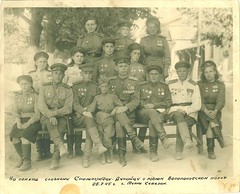I do not know story of that particular photograph.
In general mascots, or in Russian “Сын полка” (Regiments son), were relatively spread.
Usually boys would be adopted when so many children missed their families. Their role was not ment for fighting and the first line troops, IIRC, did not have them much, they normally would do something like bringing letters around and such. But I think occasionally they did some shooting too.
This is photo of my grandmother’s unit with their Regiment Son:

And here is my grandfather mentions Regiment Son in his unit:[i]The celebration of 1st of May ( http://en.wikipedia.org/wiki/International_Workers’_Day ) approached. Major Pehota, who as I mentioned was our “zampolit” ( remark: Commander’s deputy for political work – not to be confused with “Commissar” ), was very busy with the preparations. Knowing that I was a student before the war he offered me the opportunity to join his orderly, Buriak, in making a newspaper poster dedicated to the celebration. Buriak was a boy aged about 14 or 15 and was regarded as our “regiment’s son” [remark: “regiment’s sons” were usually orphans picked up by the regiments on their campaigns. Hence the name “regiment’s son” indicating that a child had been adopted by the regiment]. He wore a uniform and was always “sticking his nose in everywhere”, hanging around the newcomers, reading aloud from the newspapers distributed by Sovinformbureau /i. Together we began the work. I was responsible for the design and layout and Buriak for the content – for which he went around the platoons collecting material. I remember how our zampolit Pehota criticised me because a German tank with swastika drawn by me did not look as though it had been disabled. I had to redraw it more vividly. This time he was pleased. The tank was depicted with a fractured gun barrel, a huge gaping hole in the side and a broken track. Our tanks were rushing forward belching fire and smoke.


